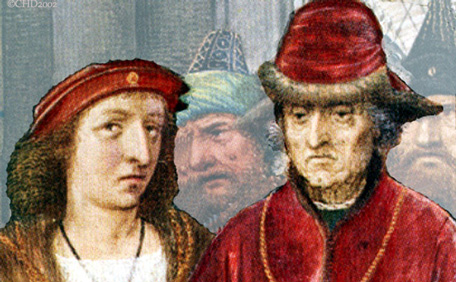
Alexander Bening and the Grimany Breviary (Ghent 1515)
An Introduction by Erik Drigsdahl

|
CHD MISCELLANEA 2002 Alexander Bening and the Grimany Breviary (Ghent 1515) An Introduction by Erik Drigsdahl |
| Simon Bening standing to the left of his father Sanders Bening, as two of the spectators witnessing the Queen of Sheeba before King Solomon (enlarged detail of fol.75v). The family likeness between the two is unmistakable, and when Simon later portrayed himself in 1558, at the age of 75, as "Alexandri filius" did he still carry the memory of his father and of this particular miniature. The 71 year old Sanders Bening was fascinated by the process of aging, and his wrinkled face and realistic turtleneck is one of the most astonishing mercylessly honest self-portraits in Netherlandish art before Rembrandt. Unlike his own likeness painted in the background on fol.192 does he not look directly at us, as his 32 year old son Simon does, but is standing adorned with the regalia of success and high prestige, as in introvert resignation before his destiny, lost in deep contemplation of his memories of a long and fruitful career approaching its end after more than 45 years of activity in close collaboration with all the best painters of his time. Dressed as he probably is, as dean of the Guild of St.Luc, is he a Nestor, the very personification of an epoch later to become known as the Ghent-Bruges School of book illumination. |
 |